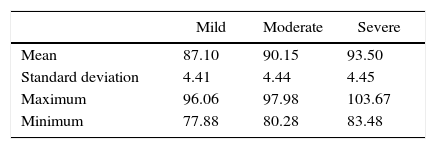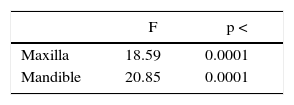Crowding has been classified as one of various types of malocclusions, which are identified as the third most prevalent oral disease. It is of great importance in orthodontics to know the mesiodistal length of teeth because it is an determining factor in the diagnosis of space discrepancies of the jaws.
ObjectiveTo determine if there is more dental mass associated with an increase in the severity of crowding.
Material and methodsA sample of 120 study models with no previous orthodontic treatment was formed. It was divided into 3 groups: 40 with mild crowding, 40 with moderate crowding and 40 with severe crowding. Mesiodistal dental widths were measured in both arches from the right first molar to the left first molar. The information was tabulated in a Microsoft Excel sheet and statistics were performed in StatCalc version 8.1.3 program. Descriptive statistics were calculated and ANOVA tests were performed.
ResultsThe average age was 16 years. In the maxilla, in the severe crowding cases, average tooth mass was 101.34mm and in the mandible, 93.50mm. In moderate crowding cases, in the upper dental arch, the average tooth mass was 98.30mm and in the lower arch, 90.15mm. In arches with mild crowding an average tooth mass of 95.06mm was found in the maxilla and of 87.10mm in the mandbile. When comparing the groups with severe crowding, statistically significant differences in the maxilla and mandible were found.
ConclusionsAs the crowding severity increases, there is more tooth mass in patients.
El apiñamiento se ha clasificado como uno de los tipos de diversas maloclusiones, las cuales están clasificadas como la tercera enfermedad bucal con mayor prevalencia. Es de gran relevancia en ortodoncia conocer la longitud mesiodistal de los órganos dentarios, ya que es un factor primordial en el diagnóstico de las discrepancias de espacio de los maxilares.
ObjetivoDeterminar si existe mayor masa dentaria conforme aumenta la severidad del apiñamiento.
Material y métodosSe conformó una muestra de 120 modelos de estudio previos al tratamiento de ortodoncia, que se dividió en tres grupos: 40 con apiñamiento leve, 40 con apiñamiento moderado y 40 con apiñamiento severo. Se midieron los anchos mesiodistales en ambas arcadas de primer molar derecho a su homónimo izquierdo. Se tabuló la información en una hoja de Microsoft Excel y se realizó la estadística en el programa StatCalc versión 8.1.3. Se calculó la estadística descriptiva y se realizaron pruebas de ANOVA.
ResultadosEl promedio de edad fue de 16 años. Se encontró en el maxilar superior, en el apiñamiento severo un promedio de masa dentaria de 101.34mm y en maxilar inferior de 93.50mm en el apiñamiento moderado, en la arcada superior se encontró un promedio de masa dental de 98.30mm y en el arco inferior de 90.15mm. En arcadas con apiñamiento leve se encontró un promedio de masa dentaria en maxilar de 95.06mm y en mandíbula de 87.10mm. Al compararse los grupos severidad de apiñamiento, se encontraron diferencias estadísticamente significativas en el maxilar y en la mandíbula.
ConclusionesConforme aumenta la severidad de apiñamiento, existe mayor masa dentaria en los pacientes.
Malocclusions may be defined as any alteration of the occlusal relationships and may occur due to anomalies of form and function of the soft tissues, jaws, teeth and temporomandibular joints.1 According to the World Health Organization malocclusions constitute the third place among oral diseases after caries and periodontal disease.1,2
Dental crowding is a problem that may be found as soon as teeth erupt, along with other anomalies that may need early correction to avoid problems that may affect occlusion, its normal development and which may progress into a malocclusion.3
Crowding is a physiological process that may occur in both the deciduous and permanent dentition in which the available space in the basal bone is less than the space required for teeth and therefore during crown formation, dental crowding will be unavoidable.4,5
The etiology of crowding may involve several factors such as growth, dental arch length reduction, maturation, aging of teeth or mesial movement of the same, soft tissues pressure, mesiodistal size of the teeth as well as tooth proportion and morphology.6,7
One of the greatest challenges and problems to be solved in orthodontics is dental crowding,8,9 so information regarding dental discrepancies between mesiodistal width of the maxillary and mandibular teeth and their effects over occlusion must be considered since that could be associated with crowding.10
Tooth size and crowding have been associated in several studies, however conclusions are still in disagreement. Although tooth size is not the only factor involved in dental crowding,11 if it is considered of outmost importance for developing space anomalies in the dental arches that may lead to crowding.12
To know the size of teeth is useful in anthropology and in dentistry. Orthodontically, it is paramount to know tooth size, as well as shape, which are set from an early age and mainly determined by genetics. Mesiodistal tooth length has proven to be associated to malocclusions.13
MATERIAL AND METHODSThe study universe was formed by 950 pretreatment orthodontic study models that belonged to the archive of the Orthodontics specialty of the Autonomous University of Nayarit. A convenience sample of 120 study models from the same orthodontic records laboratory was formed. The sample was divided into 3 groups of 40 models each: mild crowding, moderate crowding and severe crowding.
For group formation according to crowding degree, the discrepancy between the available space and the required space in both the maxilla and mandible was calculated. For measuring the mesiodistal width of each tooth, as well as the available space, a digital gauge (Surtek) with graduated millimeters was used.
It was considered as mild crowding a discrepancy of less than 3mm; a discrepancy between 3mm to 7.49mm was determined as moderate crowding and severe crowding was determined when there was a discrepancy of more than 7.5mm.
Each one of the measurements was captured in a 2010 Microsoft Excel worksheet and the discrepancy between the available and the required space was calculated for each patient. Statistics were conducted using the StatCalc program version 8.1.3. Descriptive statistics were computed and an ANOVA test was performed.
RESULTSThe average age of the studied population was 16 years. In the group with mild crowding an average tooth mass of 95.05mm with a standard deviation of 4.96mm was found in the maxilla; while in the same group, in the mandible, it was found that the average dental mass was 87.10mm with 4.41mm standard deviation.
In patients classified with moderate crowding, an average tooth mass of 98.30mm with a standard deviation of 4.89mm was found in the upper arch and in the lower arch, 90.15mm with a standard deviation of 4.44mm.
In the severe crowding group, an increase of 6.28mm (SD = 4.92mm) in the dental mass of the maxilla was observed with respect to patients with mild crowding. In the lower arch, an increase of 6.40mm (SD = 4.45mm) was observed compared to what was found in patients with mild crowding. The rest of the descriptive statistics may be observed in tables I and II.
When comparing the total tooth size between the three crowding groups statistically significant differences were found in the maxilla and the mandible (Table III).
DISCUSSIONThe mild crowding group presented the lowest average of total dental mass both in the upper and lower arch. Patients with severe crowding showed more dental mass in the upper and lower arches than the other groups, by which it may be deduced that the greater the severity of crowding, the greater the amount of tooth mass in the maxilla and mandible.
In a study conducted in a population of Western Uttar Pradesh it was found that the average dental mass in the maxilla in male patients with crowding was 98.84mm and in the mandible, 90.19mm,14 figures which are close to the average found in this study in patients with moderate crowding. For female patients with moderate crowding an average of 96.21mm in the maxilla and 88.74 in the mandible was found.14 These figures are similar to those found in patients with mild crowding in this study.
In the Department of Orthodontics and Dentofacial Orthopaedics in the College and Dental Hospital of Yamunanagar in India, an average of 76.52mm of total tooth mass in patients with maxillary crowding was reported and in the lower arch, an average of 67.18mm.15 The values reported in the population of India are below the averages obtained in any of the groups of this study.
Waheed and Rahbar in Pakistan found in a population with crowding and in another without crowding increased average values than those found in the maxilla of the group with severe crowding of this study. For the group with crowding the difference was 3mm and in the group without crowding the average was 2.3mm. But in the mandible, both groups showed similar values.16
In the city of Talca, Chile, mesiodistal widths were measured to determine dental discrepancies. It was found that in males have an average tooth mass of 93.01mm and women of 93.15mm.17 This study does not specify whether it is the average in the maxilla or the mandible, however its figures coincide with the severe mandibular crowding group of this study.
CONCLUSIONSPatients with mild crowding presented lower values of dental mass in the maxilla and mandible. As dental crowding increased from mild to moderate, the values of dental mass also increased; the same was true for severe crowding.
When comparing tooth mass in the mild crowding group with that of moderate and severe groups, it was found that there were statistically significant differences. According to the abovementioned results it is possible to say that as crowding severity increases, the values for tooth mass increase as well.
This article can be read in its full version in the following page: http://www.medigraphic.com/ortodoncia






